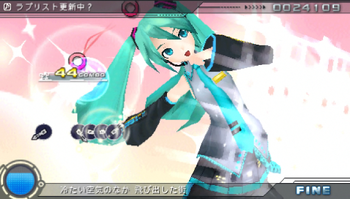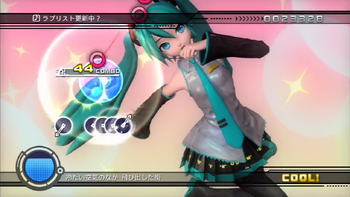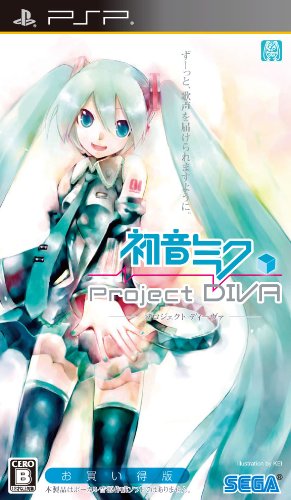Project DIVA (1st): Difference between revisions
From Project DIVA Addict
→Game Play: Changed to a list format, added information |
m →Scoring: There is no EXCELLENT rank at the end of the songs. |
||
| Line 31: | Line 31: | ||
The original Project DIVA game set the tone for scoring during normal play. However, Chance Time in this entry ends up placing an undue importance of getting a perfect combo when it comes up. Because of the high bonuses that are awarded, some songs can not be passed unless you get a perfect Chance Time. | The original Project DIVA game set the tone for scoring during normal play. However, Chance Time in this entry ends up placing an undue importance of getting a perfect combo when it comes up. Because of the high bonuses that are awarded, some songs can not be passed unless you get a perfect Chance Time. | ||
Achievement rating (STANDARD, GREAT | Achievement rating (STANDARD, GREAT) is based on what percentage your score is compared to the maximum score possible. | ||
== PV Style == | == PV Style == | ||
Latest revision as of 07:56, 4 June 2022
| ||||||||


Hatsune Miku: Project DIVA was the first entry in the Project DIVA series, even pre-dating the arcade game. It was released in 2009 with no plans for international release. Sega also released Dreamy Theater, which allowed players to play the songs on their PS3s.
Game Play
Project DIVA sets the direction the rest of the series would follow. Being the introductory title into the series, some notable features introduced in later titles are absent.
- There are no multi-notes from the arcade, nor are there any doubles or sliders.
- The game pad does not serve as an allegory to the face buttons.
- There is no Extreme difficulty setting, which is what the series would become known for.
- Accuracy rating (COOL, FINE, etc.) is displayed in the lower right of the screen instead of with the combo counter.
- There is no EXCELLENT rank at the end of songs, only MISS×TAKE, STANDARD, GREAT, and PERFECT.
Scoring
The original Project DIVA game set the tone for scoring during normal play. However, Chance Time in this entry ends up placing an undue importance of getting a perfect combo when it comes up. Because of the high bonuses that are awarded, some songs can not be passed unless you get a perfect Chance Time.
Achievement rating (STANDARD, GREAT) is based on what percentage your score is compared to the maximum score possible.
PV Style
If the PVs in Project DIVA seem a bit "generic" that's because Sega was going for sets that could be re-used across multiple PVs. While the home games would not see much re-use of these sets, quite a few of the early arcade PVs would. Sega would quickly shift focus away from generic re-usable sets and focus more on dedicated sets for each PV for each song.
Project DIVA also features a few PVs which are merely image slide shows. As the arcade would go on to feature full-motion video PVs, it's conceivable Sega wanted to do this for the PSP but could not due to both limitation of the PSP hardware and of hardware video acceleration at the time of the PSP's launch. Sega turned the limitation into an opportunity by featuring fan-made art into these slide show PVs.
Framerate
The original Project DIVA for PSP is notorious for frame skipping. Sega was building their own engine from scratch for this series, and they wanted the graphics to be impressive for the system and its time. Unfotunately this means that actual game play can suffer as the framerate dips as low as 15fps at times.
Dreamy Theater
Sega released a "partner" game called Dreamy Theater for the PS3. The game required a save file from Project DIVA on the PSP, which the game would check for (via USB connection) every time you started it up. High scores and module unlocks were carried over from the save file on the PSP into the PS3 game, but the reverse was not possible.

